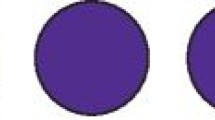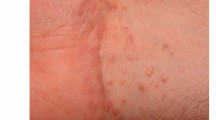Abstract
Data sources
MEDLINE/PubMed, Scopus and ISI Web of knowledge, from date of inception up to July 2017. Hand searching of the reference lists of the included studies was performed.
Study selection
Randomised (RCT) and non-randomised (n-RCT) controlled trials and controlled and comparative studies were included in patients more than 18 years old diagnosed with symptomatic oral lichen planus, histopathologically confirmed, on the use of photodynamic therapy (PDT) compared with corticosteroids, published in English.
Data extraction and synthesis
Two authors independently assessed for inclusion and performed quality assessment of the included studies following the CONSORT statement followed by the overall estimation of the risk of bias. Data extraction was also done independently by two authors. The primary outcome was the effect of PDT on pain and clinical improvement.
Results
Five studies were included: three RCTs and two n-RCTs having between eight and 30 participants. Two studies used diode laser and three used light emitting diode (LED) and the duration of the radiation ranged between 30 seconds to ten minutes. Each study used a unique corticosteroid agent. Three studies used methylene blue, one toluidine blue and one 5-aminolevulinic acid as photosensitiser agent. Follow-up was between one and three months. The authors presented the results as a narrative review.
Conclusions
The limited present evidence suggests that PDT is an effective treatment option for the management of OLP by reduction in pain, burning and decrease in the size of the lesions.
Similar content being viewed by others
Commentary
Oral lichen planus is a chronic immunologically mediated mucocutaneous disorder. In the oral mucosa it presents most commonly as white reticular striated lesions that are most often asymptomatic.1 Atrophic and erosive types present with erythematous areas and ulcers that are typically painful and elicit a symptom of burning when eating spicy food.1 OLP is considered potentially premalignant, requiring patients to routinely follow up regardless of treatment.
The standard treatment for symptomatic, erythematous or ulcerative lichen planus, is corticosteroids, topical or systemic. Long-term use of systemic corticosteroids may lead to complications including adrenal insufficiency, hypertension and diabetes, while topical corticosteroid use may predispose a patient to candidiasis. Steroid sparing treatment modalities are often needed.
This study is a systematic review of the efficacy of an emerging treatment modality, PDT, in the management of OLP. PDT involves topical or systemic treatment with a photosensitiser drug followed by light irradiation with a wavelength specific to the absorbance of the photosensitiser. The interaction produces cytotoxic oxygen free radicals which are released and destroy targeted inflammatory cells while sparing normal tissue.
There is heterogeneity in the treatment modalities used in the studies reviewed. Five studies were included in this review, with three different photosensitisers (all topical) and two different lasers (with different wavelengths). Other differences in study designs include duration of irradiation and pre-irradiation. Pre-irradiation time ranged from five to thirty minutes. The frequency of treatment differed between once a week,2 four treatments over two weeks,3 once per week for two months,4 twice per week for one month5 and one single treatment.6 While all studies compared PDT to an active control group treated with topical corticosteroids, the actual corticosteroid used and their potencies differed. A topical corticosteroid group compared to a group treated with a light suggests that these studies did not have patient blinding or evaluator masking.
The patients included all had biopsy proven OLP. In three of the studies patients were described as having erosive lesions. In the Bakhtiari study patients with reticular and erosive lesions were included (30 pts) and the Maloth study included eight patients with biopsy proven OLP, but no explanation of what types of lesions (erosive, ulcerative or striae) were being treated. To determine efficacy It would be more beneficial to know specifically if there was frank ulceration or just striae before treatment.
All of the studies used the visual analog scale (VAS) to measure changes in pain and evaluated the lesions clinically. Three studies additionally used Thongprasom sign scoring (TSS) to evaluate clinical improvement.8 VAS scores from all studies support the effectiveness of PDT in reduction of pain and burning.
The follow-up times ranged between one and three months. It would be beneficial to know if the patients were being treated during the follow-up period. Typically topical corticosteroid use is continuous in erosive lichen planus patients until resolution, with the expectation that the lesions will recur and then re-introduction of treatment would be warranted.
The sample size of the included studies range from eight to 30, and the total number of subjects treated with PDT forty-four. As pointed out by the authors, it is unclear if the power of these studies was insufficient to support the evidence of the effectiveness of PDT. Also it is unclear the magnitude used, as determined by the pain scale, that was considered significant and its clinical relevance.
While PDT may have the extra benefit of little to no side effects it does have the disadvantage of extra office visits and perhaps the bad taste of the photosensitiser. Although there is a high risk of bias and a low power from these studies, the potential benefit of no side effects and the limited evidence of its effectiveness (from the studies reviewed) for OLP, warrants the need for more studies with more subjects and longer follow-up periods. It would also be interesting to include oral lichenoid lesions (clinically and histologically similar to OLP but which have an underlying causative agent) in future studies, as they tend to be erosive and symptomatic.
References
Warnakulasuriya S . Clinical features and presentation of oral potentially malignant disorders. Oral Surg Oral Med Oral Pathol Oral Radiol 2018; 125:582–590.
Saleh WE, Khashaba O, El nagdy S, Moustafa MD . Photodynamic therapy of oral erosive lichen planus in diabetic and hypertensive patients. J Dent 2014; 1:119–123.
Bakhtiari S, Azari-Marhabi S, Mojahedi SM, Namdari M, Rankohi ZE, Jafari S . Comparing clinical effects of photodynamic therapy as a novel method with topical corticosteroid for treatment of Oral Lichen Planus. Photodiagnosis Photodyn Ther 2017; 20:159–164.
Mostafa D, Moussa E, Alnouaem M . Evaluation of photodynamic therapy in treatment of oral erosive lichen planus in comparison with topically applied corticosteroids. Photodiagnosis Photodyn Ther 2017; 19:56–66.
Jajarm HH, Falaki F, Sanatkhani M, Ahmadzadeh M, Ahrari F, Shafaee H . A comparative study of toluidine blue-mediated photodynamic therapy versus topical corticosteroids in the treatment of erosive-atrophic oral lichen planus: a randomized clinical controlled trial. Lasers Med Sci 2015; 30:1475–1480.
Maloth KN, Velpula N, Kodangal S, et al. Photodynamic therapy - a non-invasive treatment modality for precancerous lesions. J Lasers Med Sci 2016; 7:30–36.
Thongprasom K, Luangjarmekorn L, Sererat T, Taweesap W . Relative efficacy of fluocinolone acetonide compared with triamcinolone acetonide in treatment of oral lichen planus. J Oral Pathol Med 1992; 21: 456–458. PubMed PMID: 1460584.
Author information
Authors and Affiliations
Additional information
Address for correspondence: Sadeq Ali Al-Maweri, Department of Oral Medicine and Diagnostic Sciences, AlFarabi Colleges, Riyadh, Saudi Arabia. E-mail: sadali05@hotmail.com
Al-Maweri SA, Ashraf S, Kalakonda B, Halboub E, Petro W, AlAizari NA. Efficacy of photodynamic therapy in the treatment of symptomatic oral lichen planus: A systematic review. J Oral Pathol Med 2018; 47: 326–332. doi: 10.1111/jop.12684. [Epub ahead of print] Review. PubMed PMID: 29350426.
Rights and permissions
About this article
Cite this article
Fischoff, D., Spivakovsky, S. Photodynamic therapy for symptomatic oral lichen planus. Evid Based Dent 19, 90–91 (2018). https://doi.org/10.1038/sj.ebd.6401330
Published:
Issue Date:
DOI: https://doi.org/10.1038/sj.ebd.6401330



